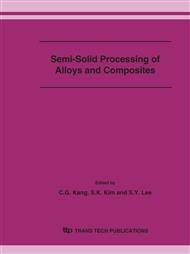p.505
p.509
p.513
p.518
p.522
p.526
p.530
p.534
p.538
Analysis of the Age-Hardening T5 Treatment in a Al-7%Si-0.6%Mg-0.5%Cu Rheo-Cast Alloy
Abstract:
The tensile properties and the microstructure of an Al-7%Si-0.6%Mg-0.5%Cu rheo-cast component were investigated. The material underwent a T5 treatment, consisting in ageing at 160, 175 and 190°C for durations ranging from 0.5 to 48h. Tensile testing indicated that the T5 treatment resulted in a relatively good level of strength and in a comparatively low ductility. In order to improve ductility, maintaining as low as possible the cost of the final component, a single solution treatment at 500°C for 4h was subsequently applied. The tensile strength and ductility of the solution treated and aged material were higher than in the T5 condition. These differences were attributed to the microstructural evolution occurring during exposure at 500°C, in particular to the spheroidization of eutectic-Si and to a more homogeneous distribution of the precipitates.
Info:
Periodical:
Pages:
522-525
Citation:
Online since:
October 2006
Keywords:
Price:
Сopyright:
© 2006 Trans Tech Publications Ltd. All Rights Reserved
Share:
Citation:


